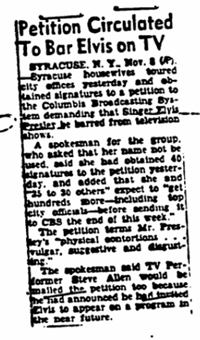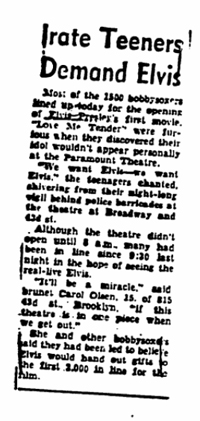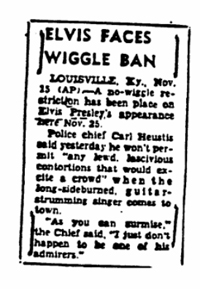
History of Popular Music from 1950
The history of pop music is tied up in the history of the technology that delivers it. Over the past couple of centuries, new technologies have enabled artists and songwriters to reach new and bigger audiences with their music, first with the single, basic unit of one song, then with album collections and, ultimately, videos straight to their phones.
- For the history of Popular Music from the 1800s to 1950, click here.
Rhythm & Blues, Rock'n'Roll
The era of modern popular music begins with rock 'n' roll in the early 1950s. Like Jazz, rock'n'roll was a revolutionary hybrid of the music that came before it (Jazz, blues, country, swing, gospel). In the late 1940s, musicians whittled down the Big Band format to its bare minimum (vocals, string bass, drums, piano, brass) and devised a bouncy, jazz-tinged syncopated version of the blues they called "rhythm and blues". This music was primarily played by and marketed to the African American urban population in a still-segregated USA. Again like Jazz before it, R&B was associated with sexuality and immorality, and disapproved of by the establishment. The lyrics were laden with innuendo, and the dancing got very dirty. It was OK for the black youths in poorer parts of Chicago, New York, or Memphis to dance to this music, but it was frowned upon in polite white society. White teenagers were stuck with the tame crooners their parents approved of: Bing Crosby, Dean Martin, Frank Sinatra, Pat Boone.
Until, one day, a young man named Elvis Presley had a great idea for a birthday present for his mother:
"The Memphis Recording Service, in addition to recording bar mitzvahs, weddings and making off-the-air transcriptions for local radio stations, also recorded personal records for people walking in off the street. For four dollars they would record two songs. A young truck driver in Memphis named Elvis Presley stopped in one day on his lunch hour to record a song for his mother's birthday. Sam Phillips was not there that day, so Marion Keisker, the Sun office manager, recorded Elvis. As Elvis sang the first song she decided to make a tape copy to play for Sam. She not only played the song for Sam Phillips, but kept pushing Sam to use the young singer. Eight months later, in 1954, when he needed a singer for a song called "Without You", Sam called Elvis Presley into the studio. Elvis was terrible on the song, so Phillips asked him what else he could do. Elvis sang religious, gospel, western and even Dean Martin material. Elvis told Sam he was looking for a band and Sam put him in touch with Scotty Moore and Bill Black. Elvis rehearsed with Scotty and Bill and then went back to the Sun studios. The first song recorded was "I Love You Because" and some other country oriented songs. During a break, Elvis, Scotty and Bill were messing around in the studio, Elvis was banging on a guitar and singing "That's All Right, Mama" an old country blues song by Arthur "Big Boy" Crudup. When Sam Phillips heard this, he told Elvis to start over and he would record it. Sam Phillips recognized that in Elvis he had what he had been looking for, a white singer who sounded black. They knew that "That's All Right, Mama" (Sun 209) would be the first single for Elvis Presley. During the next few days, they recorded Bill Monroe's "Blue Moon of Kentucky" for the second side of the single. Sam took a dub of the record to Dewey Phillips, Sam's former business partner and top DJ on WHBQ. Dewey played the song over and over, listeners called in with their enthusiastic reaction. Dewey called Elvis into the studio for an on-air interview, emphasizing that Elvis was a graduate of Humes High School. Dewey said later he wanted to get that out since many listeners thought Elvis was black and Humes was an all-white school."
—The Sun Label Records Story by David Edwards and Mike Callahan
Here's some early footage of Elvis at Sun. It's easy to see (and hear) his appeal:
By pairing down'n'dirty rhythm and blues with a soulful, clean-cut, extremely good-looking white boy, Sam Phillips created an irresistible pop culture combination. Presley's first records with Sun Records were hits on the Country and Western charts, and, thanks to constant touring, promotion on the Louisiana Hayride radio show, and rapid-fire record releases on Sun (twenty in just over 18 months, 1954-55), he became a regional star from Tennessee to West Texas. Although he was classified as a Country star for chart purposes, in reality he was playing a new hybrid, country-infused rhythm and blues, which would evolve into rockabilly, and then rock'n'roll. Presley became too big for Sun, and was signed up by promoter Colonel Tom Parker, who was determined to make his new protegee a national success. A new record contract, with RCA/Victor soon followed, as did a Hollywood deal.
Pop Music and Television
Television was the next big technical innovation that had an impact on the way people consumed popular music. Radio broadcasts were ideally suited to the era of Big Band music, where musicians stood on stage in large groups, and were fairly static. Dancers stayed on the dancefloor. However, TV viewers wanted a little more action. They were about to get it.
Bill Haley and the Comets introduced American TV audiences to rock'n'roll with Rock Around the Clock on the Ed Sullivan Show in 1955. But it wasn't until a year later, with 21 year old Elvis Presley's performance of Hound Dog on the Milton Berle Show, that the full, scandalous, sexy possibilities of the modern popstar swam into focus on TV screens.
Reactions To Elvis
Although it wasn't his first TV performance, this rendition of Hound Dog and the accompanying gyrations created a media storm that rocketed Elvis to national and international attention. He provided a flashpoint for fears about juvenile delinquency and moral decay in society. Critics slammed his singing and dancing, and rival TV host Ed Sullivan swore Elvis would never appear on his show (although 2 months later he was booked for $50K for three performances). Preachers denounced Elvis from their pulpits.
Critics
"Mr. Presley has no discernible singing ability....For the ear, he is an unutterable bore...His one specialty is an accented movement of the body that heretofore has been primarily identified with the repertoire of the blonde bombshells of the burlesque runway. The gyration never had anything to do with the world of popular music and still doesn't" (New York Times)
"Tinged with the kind of animalism that should be confined to dives and bordellos" (New York Daily News)
"Makes up for vocal shortcomings with the weirdest and plainly suggestive animation short of an aborigine's mating dance" (New York Journal-American)
"Beware of Elvis Presley" (Catholic Weekly)
Parents,Teenage Girls and Cops
These newspaper articles are all from November, 1956:



As ever, it wasn't really about the music, or one good, clean-living Christian boy who liked to sing, play guitar, and jiggle his hips in a curious mixture of keeping time and nervousness. It was about the fear of integration, fear of the social changes that the Second World War had set in motion. The older generation, the white establishment, feared Elvis because he was a white boy who sang black music, his soulful voice turning teenagers on to the "tribal rhythms" of R&B. Growing up, Elvis made no secret of his love of gospel music (he attended services at the colored East Trigg Baptist Church in Memphis), and he never attempted to hide that many of his musical heroes were black. When he hit the big time he continued to attend coloured events in Memphis, and was frequently photographed with black musicians.
“A lot of people seem to think I started this business. But rock n roll was here a long time before I came along...Nobody can sing that kind of music like colored people...Let's face it: I can't sing like Fats Domino can. I know that.”
Elvis Presley in JET magazine, 1957
From a 21st century perspective, it's hard to understand how one man and his guitar could pose such a threat to the established order. However at that time music, like every other aspect of culture, was strictly segregated along color lines. So-called "race records" were sold at different shops, played on different radio stations and marketed to a different audience. Any DJ who played these "race records" on the radio risked being called a "nigger-lover" or worse. Nat "King" Cole was attacked by racists who stormed the stage during a concert in Birmingham, Alabama in 1956. The thought of white teenagers dancing and singing alongside their coloured counterparts sent many a Southern supremacist into fits of rage, and campaigns were launched to stamp out the rock'n'roll menace.
Once Elvis had performed on TV, it was clear that the segregationists were fighting a lost cause against the music. Unlike jazz, whose integrated audiences had hidden themselves behind the closed doors of speakeasies, and whose black performers suffered prejudice and discrimination in silence, rock'n'roll was out and proud about the blend of black and white rhythm and soul. By 1957, mixed group tours were happening, with Fats Domino and Buddy Holly playing on the same stage to a mixed crowd. Although he never spoke publicly about integration, and considered himself an entertainer, not an activist, Presley's acknowledgement of and open-ness towards non-white culture represented revolution of a sort. It also opened the minds of many of the teenagers who enjoyed his hybrid music, and they would grow into adulthood increasingly uncomfortable with the idea of segregation.
Bono, speaking to Rolling Stone in 2004,commented on the Elvis Effect:
“I recently met with Coretta Scott King, John Lewis and some of the other leaders of the American civil rights movement, and they reminded me of the cultural apartheid rock & roll was up against. I think the hill they climbed would have been much steeper were it not for the racial inroads black music was making on white pop culture. The Beatles, the Rolling Stones, Creedence Clearwater Revival were all introduced to the blues through Elvis. He was already doing what the civil rights movement was demanding: breaking down barriers. You don't think of Elvis as political, but that is politics: changing the way people see the world.”
The bobby-soxers who grooved to Elvis on the jukebox in the latter half of the 1950s found themselves on the front lines of the Civil Rights movement in the 1960s. And modern pop music, amplified by movies, radio and TV, established itself as so much more than entertainment. It was a force for change.
Fifty Years of Pop Music - in one easy video
Pop Music History Museums
Around the world there are some fine collections of pop and rock memorabilia. These are all worth a visit (even if you only get as far as their websites):
- The Grammy Museum– Los Angeles
- Experience Music Project Museum– Seattle
- Rock and Roll Hall of Fame– Cleveland
- British Music Experience– London
- Rock'n'Soul Museum– Memphis
Further Reading
- History of Rock'n' Roll - Focuses on 1950-1963 but is comprehensive and detailed on this period
- Guardian/Observer 50 years of Pop Music
- Rock Historical Concept - thorough overview of the roots of rock, plus a comprehensive chapter on the 1980s (click to the next page)